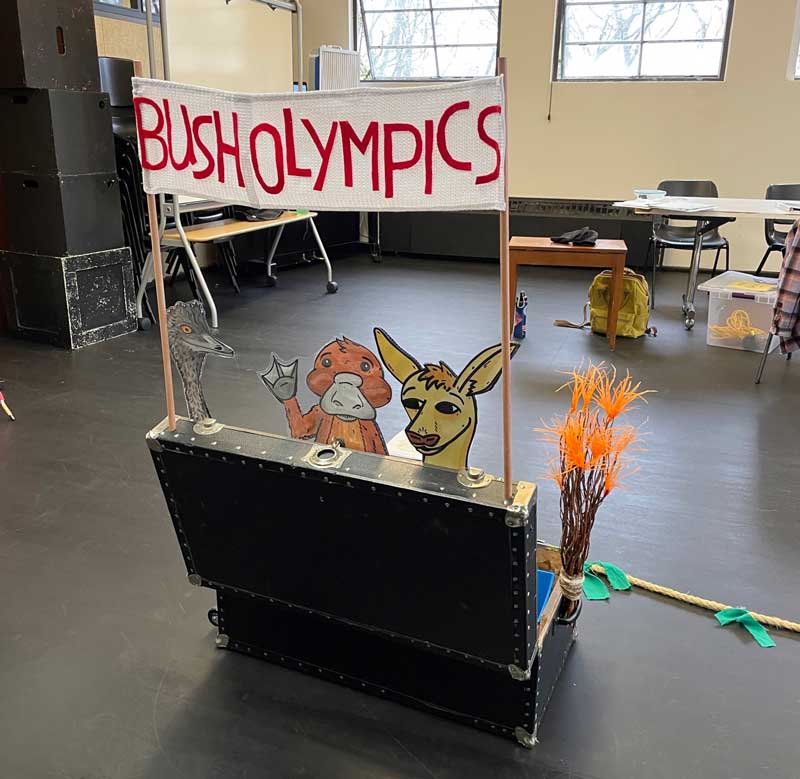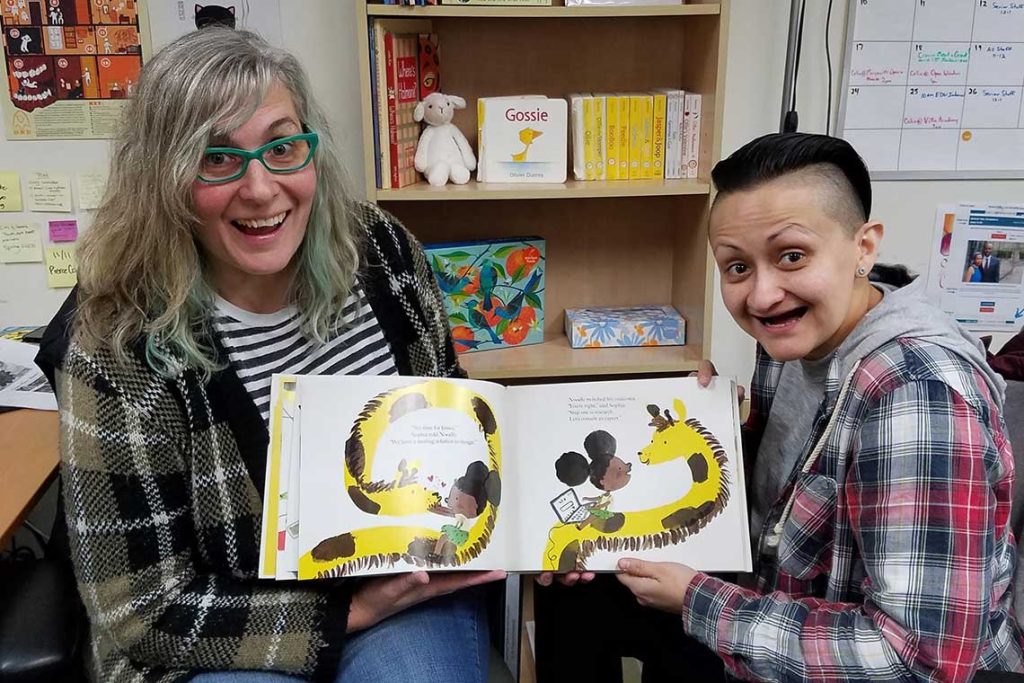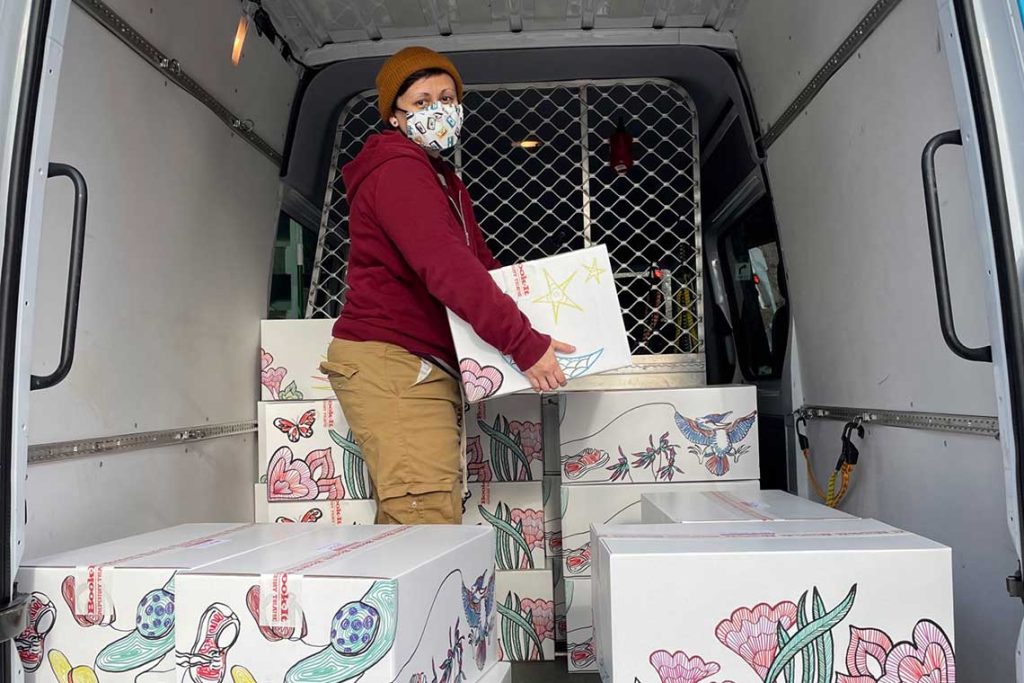For over 30 years, Book-It Repertory Theatre—located in The Armory building at Seattle Center, just underneath the iconic Space Needle—has been transforming “great literature into great theatre, through simple and sensitive production.” This process serves another part of their mission: “To inspire our audiences to read.”
With about 150 adaptations to its credit, Book-It Repertory Theatre is clearly dedicated to its mission. The nonprofit organization educates youth on literature and theatre through this process. Not only do they provide students the resources to produce plays, they also introduce children to famous authors like YuYi Morales, Mem Fox, Derrick Barnes, Jon Scieszka, Patricia Polacco, and many others. Book-It partners with schools and libraries throughout the greater Seattle area offering live performances, workshops, and giving children the opportunity to produce plays. While Book-It has primarily produced and performed plays in local Seattle venues, they have appeared in Hartford, CT, Portland, OR, Baltimore, MD, and more.
The COVID-19 pandemic has brought disruption and change to almost every aspect of our lives, and without a doubt, the arts have been impacted as well. To learn more about Book-It, and how it has been impacted by the pandemic, I met with Gillian Jorgensen, Book-It Repertory Theatre’s education director and long-time arts educator, and Jordi Montes, who has held different positions at Book-It, including tour manager and artistic producer.
They talked with me about their careers, being involved in arts education, and their experiences with today’s youth during the pandemic. Jorgensen and Montes reflect on what has changed for the organization, what has remained the same, and what they are looking forward to in the future.
“Since the pandemic, a lot has had to change…and we have had to shift. There was stuff that was hard and we were hesitant. We tour shows, we take books and turn them into plays and perform at schools and libraries around Washington—that’s what we did prior to the pandemic. When the pandemic happened, obviously, there was no more of that for the year, so we had to shift immensely,” described Montes.

She continued to tell me how Book-It had to restructure its programming to fit pandemic needs. Jorgensen and Montes, along with the rest of the team, put together a few different activities via Zoom, like workshops that were creative drama adventures, which are “essentially long-form improv guided by a teaching artist,” Jorgensen explained in an email. “We created acting, writing, visual art, and movement challenges throughout the pandemic,” added Montes. They kept the kids busy.
As Book-It slowly brings back in-person programming, they wanted to preserve the accessibility that the pandemic produced, so they turned the physical kits into digital ones. Jorgensen admitted in a confidential tone that their programs, in the past, were “inaccessible.” She then went on to explain how, historically, the main barriers for Book-It’s educational programs were distance and cost. For students further out from cities, the costs of bringing Book-It into their classroom were significantly higher than for districts within cities. Actors traveling out into suburbs creates a heavier cost that ends up being piled onto the school budget, that doesn’t have much to spare. It turns out that this option has been really popular, and many school districts are expected to continue using digital offerings for the sake of convenience and preserving opportunity.
However, Book-It is still hard at work making in-person experiences happen. For example, in-class performances are being offered now. “The whole idea is to bring students back on site,” explained Jorgensen, in a form where one actor visits a group of students in person. “There are a lot of social skills that students are missing,” she added, explaining more about why Book-It is determined to resume in-person programming.
She also added that Book-It wants to vividly present to students that jobs in the arts are a reality. To relay the same message to older students, Book-It is also offering a program called Story-Makers, in which older-aged students write, rehearse, and perform a play in the one hour they have with Book-It. Among their many goals, the organization wants to share and perform stories that students will relate to.

Oftentimes in life, we must think about the past in order to infer how we got to where we are today, and how we can make the best decisions for the future. Jorgensen reflected on how arts education has changed over the course of her 25-year career: “One of the deepest changes over the last 25 years, going on 30, is that there is a broader sense of student-focused material and the need to have student voices truly included.” One way that Jorgensen sees arts educators responding to this need is by more consistently including social-emotional learning in theatre art education.
While this is one important change in theatre arts programs, there has also been a lack of progression in different areas of the industry. “The field is moving along really slowly,” she added. “People aren’t able to stay in the field for that long because it often doesn’t pay well.” Jorgenson described how theatre and arts education lack new, excited, and driven college graduates that are passionate to enter the field. Many of those graduates are driven away because of the low salary. She mentioned, however, that not all theatres are behind. A handful, including many in Seattle and, Jorgensen specifically mentioned, New Victory Theater in New York City, are “leaders in arts education and opportunities for students.” These organizations are spearheading renewed efforts to make “sure to compensate for art, which is really awesome.”
The pandemic has taken a great toll on students. Part of moving forward is reminding students that they are important and needed. Today’s youth need to be inspired in a way that makes them driven and passionate about what they truly love to do. These activities that have been categorized as “unnecessary” during the early stages of the pandemic are now coming back, stronger than ever before.
How can we show young people that their passions are really necessary and make a difference in the world? Montes sees one solution in Book-It’s educational programming: “I’ve been working at Book-It for about eight or nine years now, and I feel that there has always been this desire to make sure that students feel seen, heard, important, part of the conversation, part of the story—that we bring stories that they see themselves in. Right now, it’s important for us as we are trying to connect with [kids] in real life.”

The pandemic has put Book-It in situations of having to adapt and improvise. But it did not stump them. They carried out their programs throughout the pandemic and are moving forward into the new year with in-person performances in January. Jorgensen and Montes, like other educators around the world, are dedicated to their work of providing opportunities to children, giving them memorable experiences, and skills to carry them through their lives and future careers. Theatres like Book-It are here to provide our youth with opportunities; they are here to support, and educate the community.
Learn more about Book-It’s arts education programs and how to get involved.
Malak Kassem is a 16-year-old high school senior from New York City. She joined Teentix Newsroom as a writer in September of 2021. She was a writer for three years and editor for one year at NYC Lab School’s paper, The Lab Report. She also has had multiple projects and roles with other organizations, such as 826NYC and Youth Journalism International. She loves to read and write, and plans to major in journalism when she goes to college next year. She loves to travel, cook, and visit museums.
This article was written on special assignment for Encore Spotlight through the TeenTix Press Corps, a program that promotes critical thinking, communication and information literacy through criticism and journalism practice for teens. TeenTix is a youth empowerment and arts access nonprofit.
